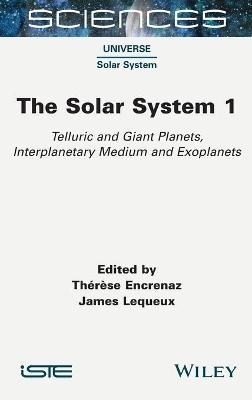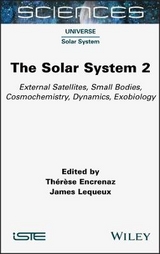
The Solar System 1
Iste Ltd (Verlag)
978-1-78945-033-0 (ISBN)
- Lieferbar
- Versandkostenfrei
- Auch auf Rechnung
- Artikel merken
The Solar System 1 deals with the Solar System as a whole, offering a general presentation of the objects that compose it and its place in the galaxy. It also deals with planetary systems, exoplanets and the interaction of Solar System objects with interplanetary medium. Finally, it analyzes the telluric and giant planets.
Thérèse Encrenaz is an astronomer emeritus at CNRS and the Paris Observatory, France, specializing in planetary atmospheres. She has directed the Observatory’s Space Research Department. James Lequeux is an honorary astronomer at the Paris Observatory, France. He has directed the Nançay Radio Observatory and the Marseille Observatory; he was also editor-in-chief of the Astronomy & Astrophysics journal.
Preface xi
Thérèse Encrenaz and James Lequeux
Chapter 1 General Presentation of the Solar System 1
Thérèse Encrenaz, Françoise Roques and Laurent Lamy
1.1 Introduction 1
1.2 Mechanics and dynamics of the Solar System 6
1.2.1 Newton’s law of gravitation 7
1.2.2 Kepler’s laws r 7
1.2.3 Mean motion resonances 9
1.2.4 The N-body problem 10
1.2.5 The role of collisions 12
1.2.6 Migrations in the Solar System 13
1.2.7 The role of gravity in a solid body 15
1.2.8 Special configurations of the Sun–Earth–Moon system 17
1.3 Physics of the Solar System 18
1.3.1 Equilibrium temperature of an object in the Solar System 19
1.3.2 Planets 22
1.3.3 Satellites 29
1.3.4 Small bodies of the Solar System 32
1.3.5 The interplanetary medium 37
1.4 References 42
Chapter 2 Solar and Planetary Systems 45
James Lequeux
2.1 The Sun in the Galaxy 45
2.2 Planetary systems in the Galaxy 47
2.3 Interstellar matter 49
2.3.1 History 49
2.3.2 Chemical composition 50
2.3.3 Physical properties 52
2.4 The formation of stars with masses close to that of the Sun 55
2.5 Circumstellar disks 63
2.6 Formation of planetesimals and planetoids 67
2.7 The environment of the Solar System at its birth 70
2.8 Detection and properties of exoplanets and their systems 71
2.8.1 First attempts 71
2.8.2 The unexpected discovery of planets around a pulsar 73
2.8.3 Exoplanet detection methods 74
2.8.4 Some statistical results 82
2.8.5 The diversity of exoplanets 83
2.8.6 Exoplanet atmospheres 88
2.8.7 Habitable planets 91
2.8.8 Some extrasolar planetary systems 94
2.9 References 95
Chapter 3 The Interaction of Solar System Bodies with the Interplanetary Medium 99
Laurent Lamy
3.1 Interplanetary plasma: origin and properties of the solar wind 100
3.1.1 Coronal expansion 100
3.1.2 The structure of the heliosphere in the ecliptic plane 103
3.1.3 The three-dimensional structure of the heliosphere 107
3.1.4 Transient structures of the solar wind 109
3.1.5 The boundaries of the heliosphere 112
3.2 Planetary envelopes 116
3.2.1 Upper planetary atmospheres 116
3.2.2 Planetary magnetic fields 124
3.3 The solar wind’s interaction with objects of the Solar System 126
3.3.1 The different types of interaction 126
3.3.2 The case of non-magnetized gaseous envelopes 129
3.3.3 The case of magnetized planets 135
3.3.4 Planetary auroral processes 153
3.4 Acknowledgements 163
3.5 References 163
Chapter 4 Telluric Planets 167
Thérèse Encrenaz, Marcello Fulchignoni and Laurent Lamy
4.1 The exploration of the telluric planets 167
4.1.1 From antiquity to the space age 167
4.1.2 The beginning of the space age 168
4.1.3 The return to Mars 169
4.1.4 The return to Venus 171
4.1.5 Observations from the ground 172
4.1.6 The exploration of planet Earth 174
4.1.7 Global Climatic Models 175
4.1.8 The electromagnetic spectrum of telluric planets 175
4.2 Objects without an atmosphere: Mercury, the Moon 177
4.2.1 Orbital parameters and macroscopic characteristics 179
4.2.2 Exospheres 180
4.2.3 Internal structure 181
4.2.4 The surfaces of Mercury and the Moon 185
4.2.5 The origin of Mercury and the Moon 194
4.2.6 Mercury’s magnetosphere 197
4.3 Objects with an atmosphere (Venus, Earth, Mars) 200
4.3.1 The interior and the magnetic field 201
4.3.2 The surface 208
4.3.3 The atmosphere 217
4.3.4 The satellites of Mars 241
4.4 References 242
Chapter 5 Giant Planets 245
Thérèse Encrenaz and Laurent Lamy
5.1 The exploration of giant planets 245
5.1.1 From Antiquity to the Space Age 245
5.1.2 Space exploration 246
5.1.3 Exploration from Earth and the terrestrial environment 251
5.1.4 The electromagnetic spectrum of giant planets 253
5.2 The atmosphere of giant planets 256
5.2.1 Atmospheric composition 256
5.2.2 Elemental and isotopic abundance ratios 257
5.2.3 Thermal structure 264
5.2.4 Atmospheric circulation and cloud structure 266
5.2.5 High atmosphere and photochemistry 269
5.3 The internal structure of giant planets 271
5.3.1 Experimental data 271
5.3.2 The construction of internal energy models 274
5.3.3 The results 276
5.4 The magnetospheres of the giant planets 279
5.4.1 Jupiter’s giant magnetosphere 279
5.4.2 Saturn’s symmetrical magnetosphere 295
5.4.3 The asymmetric magnetospheres of Uranus and Neptune 302
5.5 References 304
Appendix Web links 309
Glossary 311
List of Authors 323
Index 325
| Erscheinungsdatum | 06.01.2022 |
|---|---|
| Verlagsort | London |
| Sprache | englisch |
| Maße | 10 x 10 mm |
| Gewicht | 454 g |
| Themenwelt | Naturwissenschaften ► Geowissenschaften ► Geologie |
| Naturwissenschaften ► Physik / Astronomie ► Astronomie / Astrophysik | |
| ISBN-10 | 1-78945-033-0 / 1789450330 |
| ISBN-13 | 978-1-78945-033-0 / 9781789450330 |
| Zustand | Neuware |
| Haben Sie eine Frage zum Produkt? |
aus dem Bereich



